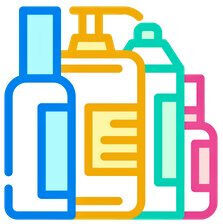
The cosmetics sector in the United States
Label for importing cosmetics into the United States
The last step for exporting cosmetics to the United States is the label review
https://www.exportusa.eu/cosmetics_label.php (+1) 718-5225575
(+1) 718-5225575
Below are some data on the American cosmetics market from ExportUSA's market research team. We believe this information is valuable for understanding U.S. market trends and for planning the export and sale of cosmetic products in the USA.
Over the past five years, the U.S. personal care market has grown by 15.2%, reaching sales of $45.2 billion.
American Millennial women (approximately 25-44 years old) are the largest purchasers of beauty products, accounting for 38%, followed by Generation X women (approximately 45-54 years old) at 18%. Regarding skincare, Generation Z has the highest percentage of buyers (41%) and spends the most on skincare products, despite having recently entered the workforce. In 2021, 37% of American Generation Z consumers spent between $10 and $20 on a single skincare product.
California is home to the most cosmetic companies (17,779), including some of the world's largest, with a 2022 revenue of $6.1 billion. No other U.S. state has such a concentration of beauty businesses; for example, New York State hosts only 10,192 companies with a revenue of $2.4 billion. It's no coincidence that California is known for its strong ability to set global trends in cosmetics, such as natural makeup and the use of products with natural ingredients.
But how large is the beauty industry? From $483 billion in 2020 to $571 billion in 2022—and with a compound annual growth rate of 4.75% worldwide—it is expected to surpass $716 billion by 2025 and $784.6 billion by 2027. The reason? A rapid expansion of online sales and an increasing number of customers willing to pay higher prices for superior quality. The American cosmetics market, along with the Asia-Pacific region, accounts for over 60% of total beauty product sales.
Mass-market distribution for facial skincare products has been the most performing distribution channel relative to the entire beauty sector.
Traditional retail stores continue to dominate, attracting (according to available data) 81% of buyers. At the same time, however, the offline market share is decreasing while the online share is rising.
Before COVID-19, 85% of beauty products sold in America were purchased in-store, while today, 23.3% of cosmetic product purchases are made through e-commerce sites. According to a 2020 survey, 60% of Americans reported increasing online purchases due to the pandemic.

The last step for exporting cosmetics to the United States is the label review
https://www.exportusa.eu/cosmetics_label.php
Gen X are the new beauty product consumers on whom to focus your marketing efforts in the United States, a target group full of opportunities
https://www.exportusa.eu/target-sales-cosmetics-unitedstates.php
Ingredients before brands: the new priority of the cosmetics industry in America
https://www.exportusa.eu/skincare-trends-beauty-sector-america.php
ExportUSA offers a well-established market research and product positioning service. We put our experience and direct contact with importers, distributors, and representatives in numerous sectors in the United States to use.
https://www.exportusa.eu/market-research-exportusa.php